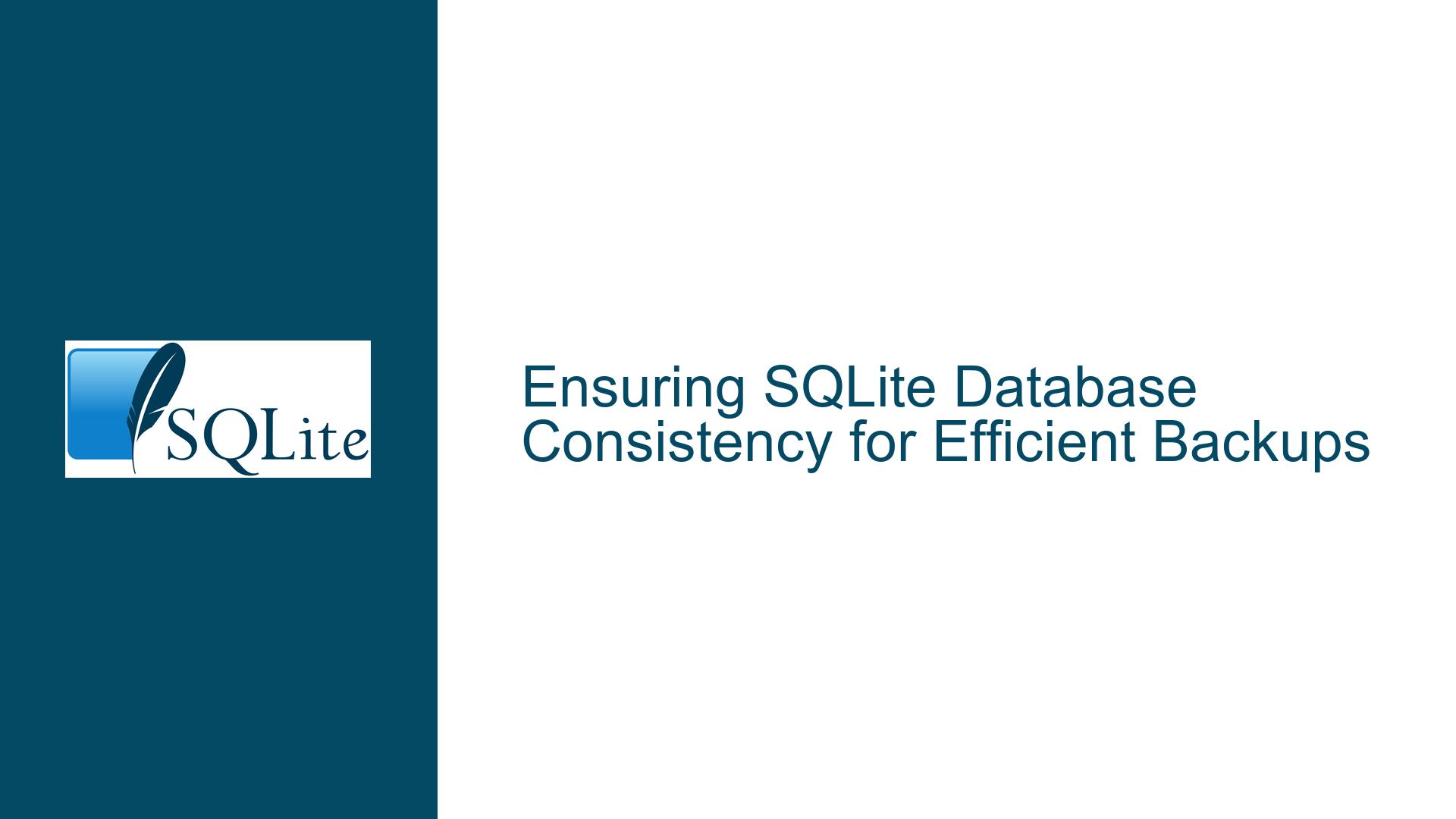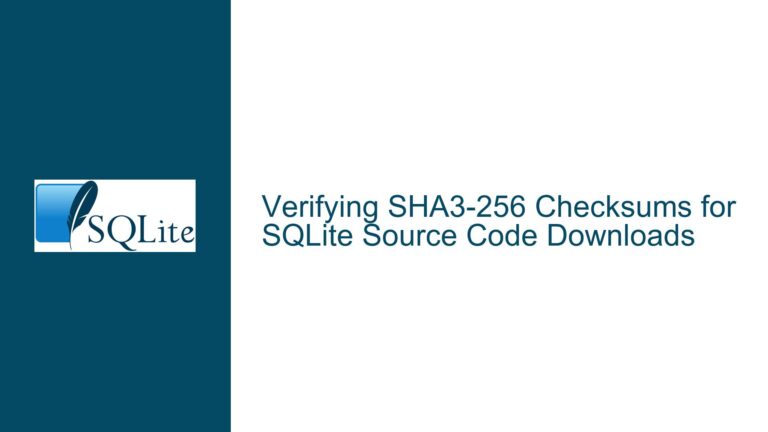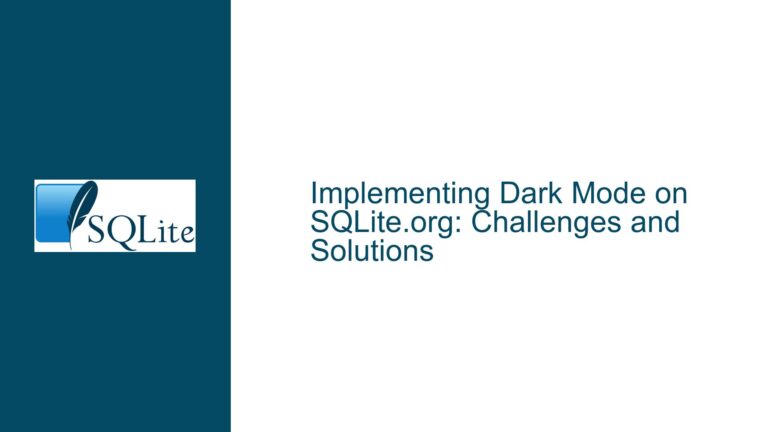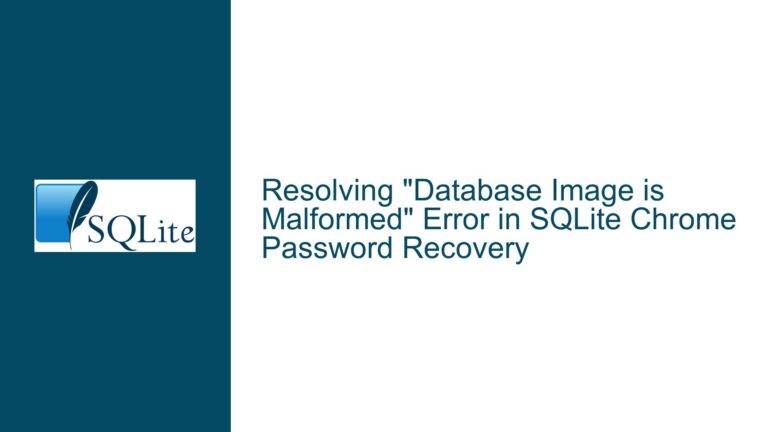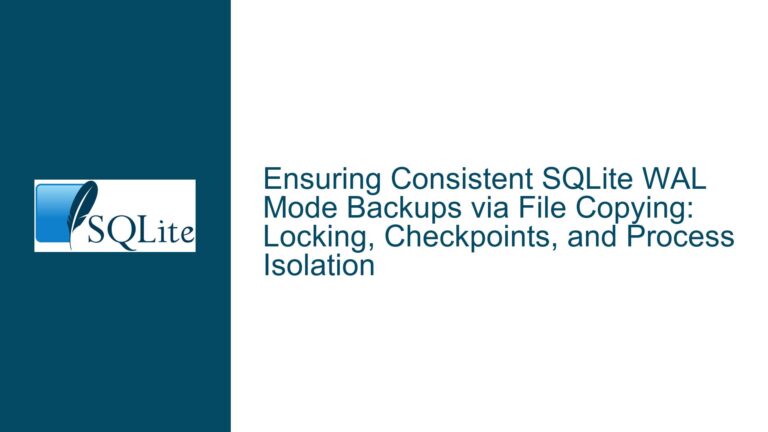Ensuring SQLite Database Consistency for Efficient Backups
Understanding Database Consistency in Backup Scenarios
Database consistency refers to the state where two or more databases contain identical information content and structural integrity. In the context of SQLite, this involves ensuring that the main database and its backup database have the same schema definitions (tables, indexes, triggers), stored data, and internal metadata. The challenge lies in determining whether differences between databases are meaningful (e.g., data changes) or incidental (e.g., file reorganization due to VACUUM operations).
A backup strategy that avoids redundant copies requires distinguishing between these scenarios. For example, if the backup database already matches the main database, creating a new backup wastes storage and computational resources. However, relying solely on superficial checks (e.g., file size or modification timestamps) can lead to false positives or negatives. Two primary approaches exist for verifying consistency:
- Content-Based Comparison: Generating cryptographic hashes (e.g., MD5) of database files or individual tables.
- Structural Comparison: Validating schema objects, row data, and metadata (e.g., schema version numbers).
The choice between these methods depends on the application’s requirements. Content-based checks are faster but may fail if the database undergoes non-semantic changes (e.g., page reordering). Structural comparisons are more precise but computationally intensive.
Factors Influencing Backup Consistency Checks
1. Internal File Reorganization via VACUUM
The VACUUM command rebuilds the database file, reclaiming unused space and optimizing storage. This process alters the physical layout of data pages but preserves logical content. For example, a database before and after VACUUM will have different MD5 hashes or file sizes despite containing identical data. Relying on file-level checks alone would incorrectly flag these as inconsistent.
2. Index and Schema Modifications
Adding, modifying, or removing indexes changes the database schema but not the underlying data. Whether such changes invalidate consistency depends on the application’s definition. For instance, an index added to improve query performance might be considered a non-critical change if the backup’s purpose is data preservation.
3. Prepared Statements and Schema Version
SQLite tracks schema changes using the schema_version integer in the database header. This value increments whenever a schema-altering operation (e.g., CREATE TABLE, ALTER TABLE) occurs. Applications using prepared statements must re-prepare them if the schema version changes. A mismatch in schema_version between databases indicates structural differences that could affect application behavior.
4. User-Defined Version Control
The user_version field in the database header is a 32-bit integer controlled by the application. It serves as a custom versioning mechanism. For example, an application might increment user_version after data migrations or critical updates. If the backup process checks this value, mismatches signal logical inconsistencies even if schemas match.
5. Backup Methodology
How the backup is created affects consistency checks:
- File Copy: Directly copying the database file preserves the physical structure but is sensitive to
VACUUMoperations. - Logical Backup: Exporting data via
.dumporsqlite3_backupAPI creates a schema-and-data reconstruction script. This method avoids file layout dependencies but may lose ancillary information (e.g.,user_version).
Implementing Reliable Database Comparison Strategies
1. Leverage SQLite’s Official Utilities
dbhashTool: Generates SHA1 hashes for individual tables and their contents. Unlike file-level MD5, this ignores physical storage differences.sqlite3 main.db .sha3sum --sha1 # Generate hashes for all tables sqlite3 backup.db .sha3sum --sha1 diff main_hashes.txt backup_hashes.txtMismatched hashes indicate divergent data or schemas.
sqldiffTool: Compares schemas and row-level data between two databases.sqldiff main.db backup.dbThe output lists SQL statements needed to synchronize the databases.
2. Check Schema and User Versions Programmatically
Query the schema_version and user_version fields to detect structural or logical changes:
-- Retrieve schema and user versions
PRAGMA main.schema_version;
PRAGMA main.user_version;
-- Compare with backup database
PRAGMA backup.schema_version;
PRAGMA backup.user_version;
A discrepancy in schema_version suggests schema alterations, while a user_version mismatch implies application-specific changes.
3. Validate File Size and Cryptographic Hashes with Caution
While file size and MD5 checks are fast, they should be combined with other methods:
# Check file sizes
ls -l main.db backup.db
# Generate MD5 hashes
md5sum main.db backup.db
If sizes and hashes match, the databases are likely identical. If they differ, further investigation (e.g., dbhash or sqldiff) is required.
4. Incorporate VACUUM Awareness into Backup Logic
Schedule VACUUM operations during maintenance windows and refresh backups afterward. Alternatively, use write-ahead logging (WAL) mode, which reduces fragmentation and minimizes the need for VACUUM.
5. Automate Consistency Checks in Backup Scripts
Embed checks into backup workflows:
#!/bin/bash
# Generate dbhash for main database
sqlite3 main.db .sha3sum --sha1 > main_hash.txt
# Compare with backup
if ! sqlite3 backup.db .sha3sum --sha1 | diff -q main_hash.txt -; then
echo "Backup inconsistent. Creating new backup..."
cp main.db backup.db
fi
6. Custom Triggers for Application-Specific Versioning
Use triggers to update user_version when critical data changes:
-- Increment user_version after inserting into a key table
CREATE TRIGGER increment_user_version AFTER INSERT ON transactions
BEGIN
UPDATE pragma_user_version SET user_version = user_version + 1;
END;
This ensures backups reflect the latest application state without full-content scans.
7. Hybrid Approach for High-Stakes Environments
Combine multiple methods for redundancy:
- Check
schema_versionanduser_versionfor quick validation. - Run
dbhashon critical tables. - Perform a full
sqldiffif prior steps indicate potential mismatches.
This balances speed and thoroughness, minimizing unnecessary backups while ensuring data integrity.
By integrating these strategies, developers can tailor backup consistency checks to their application’s needs, avoiding redundant operations while safeguarding against data loss or corruption.
